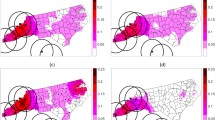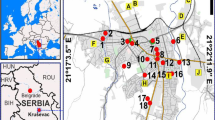Abstract
The presence of polyhalogenated persistent organic pollutants (POPs), such as Cl/Br-substituted benzenes, biphenyls, diphenyl ethers, and naphthalenes has been identified in all environmental compartments. The exposure to these compounds can pose potential risk not only for ecological systems, but also for human health. Therefore, efficient tools for comprehensive environmental risk assessment for POPs are required. Among the factors vital for environmental transport and fate processes is melting point of a compound. In this study, we estimated the melting points of a large group (1419 compounds) of chloro- and bromo- derivatives of dibenzo-p-dioxins, dibenzofurans, biphenyls, naphthalenes, diphenylethers, and benzenes by utilizing quantitative structure—property relationship (QSPR) techniques. The compounds were classified by applying structure-based clustering methods followed by GA-PLS modeling. In addition, random forest method has been applied to develop more general models. Factors responsible for melting point behavior and predictive ability of each method were discussed.






Similar content being viewed by others
References
de Lima Ribeiro FA, Ferreira M (2003) QSPR models of boiling point, octanol–water partition coefficient and retention time index of polycyclic aromatic hydrocarbons. J Mol Struc 663:109–126
Nadal M, Espinosa G, Schuhmacher M, Domingo JL (2004) Patterns of PCDDs and PCDFs in human milk and food and their characterization by artificial neural networks. Chemosphere 54:1375–1382
Ding G, Chen J, Qiao X, Huang L, Lin J, Chen X (2006) Quantitative relationships between molecular structures, environmental temperatures and solid vapor pressures of PCDD/Fs. Chemosphere 62:1057–1063
Xu HY, Zou JW, Yu QS, Wang YH, Zhang JY, Jin HX (2007) QSPR/QSAR models for prediction of the physicochemical properties and biological activity of polybrominated diphenyl ethers. Chemosphere 66:1998–2010
Ritter L, Solomon KR, Forget J, Stemeroff M, O'Leary C (1995) Persistent organic pollutants: an assessment report, International Programme on Chemical Safety. World Health Organization, Canada
Balk S, Carpenter DO, Corra L, Diaz-Barriga MFR, Sly P, Ehrenstein OSV, Tirado MC (2010) Persistent organic pollutants: impact on child health. Geneva, Switzerland.
Nicolopoulou-Stamati P, Pitsos MA (2001) The Impact of endocrine disrupters on the female reproductive system. Hum Reprod Update 7:323–330
Katritzky AR, Maran U, Lobanov VS, Karelson M (2000) Structurally diverse quantitative structure–property relationship correlations of technologically relevant physical properties. J Chem Inf Comput Sci 40:1–18
Vasseur P, Cossu-Leguille C (2006) Linking molecular interactions to consequent effects of persistent organic pollutants (POPs) upon populations. Chemosphere 62:1033–1042
Katritzky AR, Maran U, Karelson M, Lobanov VS (1997) Prediction of melting points for the substituted benzenes: a QSPR approach. J Chem Inf Comp Sci 37:913–919
Katritzky AR, Lomaka A, Petrukhin R, Jain R, Karelson M, Visser AE, Rogers RD (2002) QSPR correlation of the melting point for pyridinium bromides, potential ionic liquids. J Chem Inf Comp Sci 42:71–74
Schultz TW, Cronin MTD, Walker JD, Aptula AO (2003) Quantitative structure–activity relationships (QSARs) in toxicology: a historical perspective. J Mol Struct 622:1–22
Bolboaca SD, Jäntschi L (2013) Quantitative structure-activity relationships: linear regression modelling and validation strategies by example. Biomath 2(1):1–11
Asadollahi T, Dadfarnia S, Shabani AM, Ghasemi JB, Sarkhosh M (2011) QSAR models for CXCR2 receptor antagonists based on the genetic algorithm for data preprocessing prior to application of the PLS linear regression method and design of the new compounds using in silico virtual screening. Molecules 16:1928–1955
Gramatica P, Consolaro F, Pozzi S (2001) QSAR approach to POPs screening for atmospheric persistence. Chemosphere 43:655–664
Dudek AZ, Arodz T, Galvez J (2006) Computational methods in developing quantitative structure-activity relationships (QSAR): a review. Comb Chem High T Scr 9:213–228
OECD (2014) A guidance document on the validation of (quantitative) structure-activity relationship [(Q)SAR] models. http://www.oecd.org/dataoecd/33/37/37849783.pdf (accessed July 13)
Bhhatarai B, Teetz W, Liu T, Öberg T, Jeliazkova N, Kochev N, Pukalov O, Tetko IV, Kovarich S, Papa E, Gramatica P (2011) CADASTER QSPR models for predictions of melting and boiling points of perfluorinated chemicals. Mol Inf 30:189–204
Trohalaki S, Pachter R, Drake GW, Hawkins T (2005) Quantitative structure–property relationships for melting points and densities of ionic liquids. Energy Fuels 19:279–284
Katritzky AR, Jain R, Lomaka A, Petrukhin R, Maran U, Karelson M (2001) Perspective on the relationship between melting points and chemical structure. Cryst Growth Des 1:261–265
Godavarthy SS, Robinson RL Jr, Gasem KAM (2006) An improved structure–property model for predicting melting-point temperatures. Ind Eng Chem Res 45:5117–5126
Murugan R, Grendze MP, Toomey J, Katrizky A, Karelson M, Lobanov V, Rachwal P (1994) Predicting physical properties from molecular structure. Chemtech, Washington DC 24:17–17
Hanson M, Rouvray D (1987) The use of topological indices to estimate the melting points of organic molecules. Graph Theor Topol Chem 51:201–208
Abramowitz R, Yalkowsky S (1990) Melting point, boiling point, and symmetry. Pharm Res 7:942–947
Dearden JC (1991) The QSAR prediction of melting point, a property of environmental relevance. Sci Total Environ 109–110:59–68
Charton M, Charton B (1994) Quantitative description of structural effects on melting points of substituted alkanes. J Phys Org Chem 7:196–206
Gramatica P, Navas N, Todeschini R (1998) 3D-modelling and prediction by WHIM descriptors. Part 9. Chromatographic relative retention time and physico-chemical properties of polychlorinated biphenyls (PCBs). Chemomet Intell Lab Syst 40(1):53–56
Kušić H, Rasulev B, Leszczynska D, Leszczynski J, Koprivanac N (2009) Prediction of rate constants for radical degradation of aromatic pollutants in water matrix: a QSAR study. Chemosphere 75:1128–1134
Puzyn T, Gajewicz A, Rybacka A, Haranczyk M (2011) Global versus local QSPR models for persistent organic pollutants: balancing between predictivity and economy. Struct Chem 22:873–884
Howard PH, Muir DC (2011) Identifying new persistent and bioaccumulative organics among chemicals in commerce II: pharmaceuticals. Environ Sci Tech 45:6938–6946
Gajewicz A, Haranczyk M, Puzyn T (2011) Predicting logarithmic values of the subcooled liquid vapor pressure of halogenated persistent organic pollutants with QSPR: how different are chlorinated and brominated congeners? Atmos Environ 44:1428–1436
Odziomek K, Gajewicz A, Haranczyk M, Puzyn T (2013) Reliability of environmental fate modeling results for POPs based on various methods of determining the air/water partition coefficient (log Kaw). Atmos Environ 73:177–184
Puzyn T, Mostrag-Szlichtyng A, Gajewicz A, Skrzyński M, Worth AP (2011) Investigating the influence of data splitting on the predictive ability of QSAR/QSPR models. Struct Chem 22:795–804
Puzyn T, Mostrag-Szlichtyng A, Falandysz J, Kholod Y, Leszczynski J (2009) Predicting water solubility of congeners: chloronaphthalenes—a case study. J Hazard Mat 170:1014–1022
Coleman WF, Arumainayagam CR (1998) HyperChem 5 (by Hypercube Inc). J Chem Ed 75:416
Vargyas M, Papp J, Csizmadia F, Csepregi S, Papp A, Vadasz P (2008) Maximum common substructure based hierarchical clustering, Noordwijkerhout, Netherlands
Mauri A, Consonni V, Pavan M, Todeschini R (2006) Dragon software: an easy approach to molecular descriptor calculations. Match 56: 237–248
EigenVector Research (2014) EigenVector Research, I. PLS Toolbox, 7.8.2. http://www.eigenvector.com/
MATLAB (2014) MATLAB (R2014a), version 8.3. Natick, MA
Hasegawa K, Funatsu K (2000) Partial least squares modeling and genetic algorithm optimization in quantitative structure-activity relationships. SAR QSAR Environ Res 11:189–209
Liaw A, News MWR (2002) Classification and regression by random forest. R News 2:18–22
Breiman L (2001) Random forests. Mach Learn 45:5–32
Gramatica P (2007) Principles of QSAR models validation: internal and external. QSAR Comb Sci 26:694–701
Golbraikh A, Tropsha A (2002) Beware of q2! J Mol Graph Model 20(4):269–276
Acknowledgments
The authors thank the NSF CREST Interdisciplinary Nanotoxicity Center NSF-CREST – Grant # HRD-0833178; NSF-EPSCoR Award Number: 362492-190200-01\NSFEPS-0903787 for support. B.R. gratefully acknowledges support from the North Dakota State University Center for Computationally Assisted Science and Technology and the U.S. Department of Energy through Grant No. DE-SC0001717.
Author information
Authors and Affiliations
Corresponding author
Additional information
Marquita Watkins and Natalia Sizochenko contributed equally to this work.
Electronic supplementary material
Below is the link to the electronic supplementary material.
ESM 1
(PDF 1.25 mb)
Rights and permissions
About this article
Cite this article
Watkins, M., Sizochenko, N., Rasulev, B. et al. Estimation of melting points of large set of persistent organic pollutants utilizing QSPR approach. J Mol Model 22, 55 (2016). https://doi.org/10.1007/s00894-016-2917-0
Received:
Accepted:
Published:
DOI: https://doi.org/10.1007/s00894-016-2917-0




